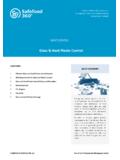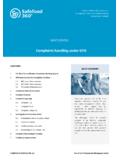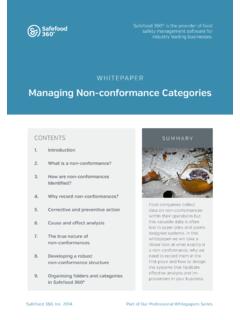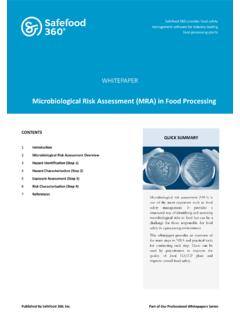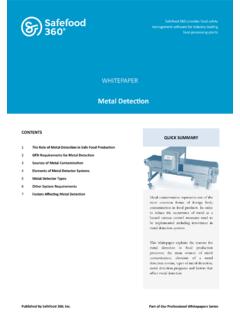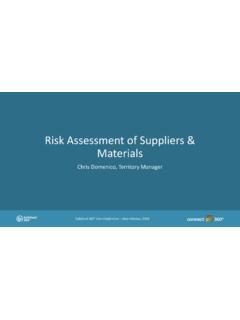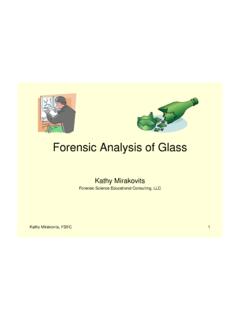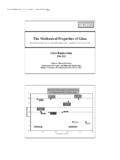Transcription of Glass & Hard Plastic ontrol - Safefood 360°
1 Safefood 360 provides food safety management software for industry leading food processing plants WHITEPAPER QUICK SUMMARY Published by Safefood 360, Inc. Part of Our Professional Whitepapers Series Foreign body hazards represent one of the most significant risks associated with the production and distribution of food products. Among these, Glass and hard Plastic are the most significant given their widespread use in food production equipment, environments and utensils. In order to mitigate against product contamination the food site must have in place effective procedures to eliminate or reduce so far as practically possible the likely occurrence of these hazards. In addition, the food plant should have in place a full risk assessment and clear policy for the control of Glass and hard Plastic . CONTENTS 1 Effective Glass and Hard Plastic Control System 2 GFSI Requirement for Glass and Plastic Control 3 Glass and Hard Plastic Control Policy and Procedure 4 New Equipment 5 The Register 6 The Audit 7 Glass and Hard Plastic Breakage Glass & Hard Plastic Control Glass & Hard Plastic Control 2 Safefood 360 Whitepaper (March, 2013) The production of a food product by its very nature presents the risk of contamination from a large variety of sources.
2 These can be both intrinsic and extrinsic in nature and in the majority of cases it is not possible to completely eliminate all hazards. Instead, our objective is to reduce the risk to an acceptable level. This allows for both the safe and economic production of food. The procedures, activities and tasks we perform to achieve this come under the general heading of food safety management and within this are a number of established control procedures designed to address common hazards. Foreign body hazards are widely recognised as potential food safety is-sues including Glass , hard Plastic , wood, metal, paper, string, tape, maintenance debris and personal effects. Glass and hard Plastic present particular difficulties given their nature and prevalence in food oper-ations. These materials can often be transparent and difficult to detect when present in food. Hard Plastic is used widely in food production equipment and machinery and can be subject to damage, wear and tear.
3 Glass and hard Plastic is a major contributor to injury when consumed in the prod-uct. They can result in claims and on occasion litigation. These and other factors require Glass and hard Plastic to be eliminated from food production areas where possible. Where this is not practi-cable control must be exercised over these materials to ensure the risk of contamination is reduced to an acceptable level. An effective Glass and hard Plastic control system will normally comprise the following elements: Glass and hard Plastic policy Glass and hard Plastic risk assessment Glass and hard Plastic control procedure New equipment assessment and risk reduction Glass and hard Plastic register Glass and hard Plastic audit program Glass and hard Plastic breakage procedure The above elements are also required to meet the specific requirements of the multiple food retail-ers and other customers. The system is focused on identifying, eliminating, reducing or protecting all Glass and hard Plastic in the operation that may present a risk.
4 The Global Food Safety Initiative s (GFSI) group of approved schemes set out very prescriptive requirements for the control of possible foreign body hazards. The BRC Standard goes into specif-ic requirements regarding Glass and hard Plastic and these can be found in section Glass & Hard Plastic Control 3 Safefood 360 Whitepaper (March, 2013) These requirements set out a system which excludes or protects against broken Glass and other brittle materials which can pose a risk of contamination. The standard also mentions open product areas where the risk is greatest. The standard introduces the use of a register of items which should be checked and records maintained. Finally, the company should have in place a system for the management of breakages of Glass and other brittle items. The first step in putting in place an effective Glass and brittle Plastic control system is to clearly define a policy and procedure. This should be documented and cover all the elements as previously described.
5 The policy should be consistent with legal and commercial requirements and sufficient to ensure consumer protection. It should include the following: Policy and controls in place Register of items and their auditing Breakage procedure The following page contains a general example of how this documented procedure might look. Glass & Hard Plastic Control 4 Safefood 360 Whitepaper (March, 2013) Quality & Food Safety Manual Glass & Hard Plastic Control Control - No Glass items shall be in the processing area. All products packed in jars SHALL ONLY be produced in the Glass Room. If this is not possible, production in the processing area must be scheduled for only the particular product that needs to be packed in Glass jars. The clean-up procedure specified in Section of this Policy shall be strictly fol-lowed. Ingredients must be purchased in non- Glass containers. If this is not possible, the Glass containers must be opened away from the processing area under the supervision of the Production Supervisor.
6 Ingredients shall then be transferred to a non-breakable container prior to entering the processing area. All lights shall be protected to effectively contain broken Glass . This is accomplished by using both: Shatterproof bulbs Plastic Shields or shields with end caps as applicable Lights should only be replaced during non-production hours when there is no ex-posed product. If a light MUST be replaced during production hours all product and pack-aging materials must be covered or moved to a sufficient distance from the fixture to pre-vent accidental contamination. Jars used solely for DIPS shall be stored in a separate rack in the warehouse. Jars shall be stored in boxes with separators to minimize breakage. Thermometers shall have Plastic covers. Breakage All Glass /brittle Plastic breakage shall be reported immediately to the QA Manager to ensure complete clean up and inspection. The clean-up procedure applies to all areas: Put all open product(s) in immediate area on Hold, remove from the area and notify Production Supervisor and QA.
7 Remove large pieces of Glass /brittle Plastic by hand (must wear gloves) and place in garbage. Sweep up the rest of the Glass /brittle Plastic shards in the area. Wash all affected areas thoroughly with water or with a damp wipe-all. Area must be checked by Production Manager or QA before resuming work in the area. Reference: 95 Page: 1 of 2 Authorised By: George Howlett Issue Date: 20 OCT 2011 Version: 2 Document Type: PRP Responsible: Quality Manager Glass & Hard Plastic Control 5 Safefood 360 Whitepaper (March, 2013) After, clean up all tools (brooms, brushes and gloves) and employees shoes must be cleaned outside of the processing area to prevent further contamination. Register and Audit The HACCP Team shall define a register of all essential Glass and brittle plastics in the production and storage areas. This register will be audited weekly and the result record-ed. The register will indicate locations of all essential Glass and brittle plastics in the pro-duction and storage areas including the number of items and any protection in place.
8 This will be completed by the QA Manager. All supervisors are responsible for immediately in-forming the QA Manager when Glass /brittle plastics are added and/or removed. Training Annual training (Internal Food Safety Program) shall include knowledge of Glass /brittle Plastic policy and associated cleaning procedures. Record Retention All records of the Glass /Brittle Plastic Control Program and activities including Glass Breakage Forms and Master List of Glass and Brittle Plastic shall be held for a period of two years. Equipment used in the production of food frequently utilises Plastic in its fabrication. When new equipment is purchased the opportunity should be taken to assess it for any items of Plastic that can be removed or protected against breakage. Modifications to existing equipment should elimi-nate Glass and clear Plastic , where possible. A record of this assessment should be maintained. Picture: New Equipment Assessment Record Glass & Hard Plastic Control 6 Safefood 360 Whitepaper (March, 2013) The Glass and brittle Plastic register is the core document of your control system.
9 It will contain a list of all Glass and Plastic items deemed to be a potential contamination risk to the final product and therefore the consumer. Glass and brittle Plastic can come from a variety of sources. These should all be considered when conducting the risk assessment and generating the register. Sources may include the following: Glass packaging used for ingredients Glass containers and jars used to package final product Lights and light covers Door panels on machines Machine parts All Glass and hard clear Plastic in production and storage areas must be listed on a register. Brittle coloured plastics should also be considered for inclusion in the register, if they pose a risk of prod-uct contamination. For example, white plastics in dough production areas, red plastics in raw meat processing areas etc. may be included on the register. When developing the register you should consider including the following details: Item name and description if required Location The number of items, 4 x Plastic panel doors Whether the item is protected against breakage Other details that may be required to conduct an effective inspection of each item Keeping the register up to date is important since it will lead to non-conformances in the certifica-tion audit and increase the risk of product contamination due to critical items not being inspected during the internal audit of the list.
10 Key members of staff, maintenance, should be trained to notify the relevant person responsible for the upkeep of the register. Picture: Sample Glass and Plastic Register Glass & Hard Plastic Control 7 Safefood 360 Whitepaper (March, 2013) Once the register is complete it should be audited based on the risk posed by the item or area, exposed product areas. More than one register may be developed to account for different risk areas and audited on a different frequency. Audits must be completed on all registered items at a fre-quency determined by risk assessment. The audit must record the condition of the item, intact, broken , damaged but intact, undam-aged but not working. Any issues raised must be investigated to establish if the Glass breakage pro-cedure has been followed and if not, whether product has been put at risk. A risk assessment must be completed to determine how quickly repairs must be made. A full record of the audit should be maintained including corrective actions.
